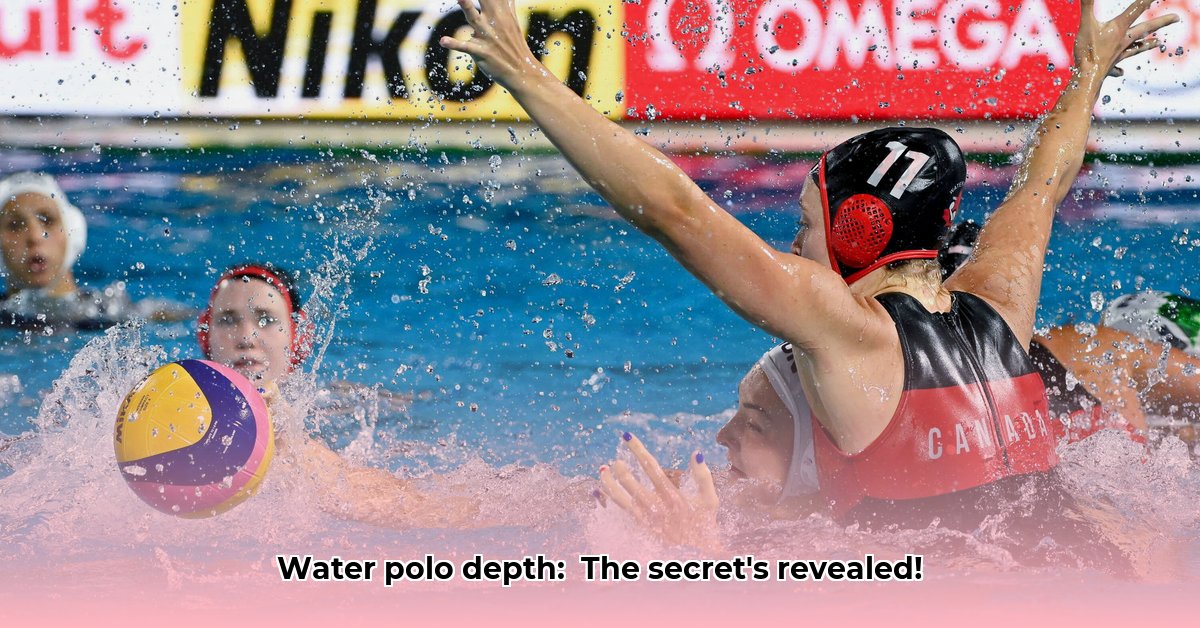Ever wonder how deep a water polo pool really needs to be? It’s not just about splashing around; the depth significantly impacts the game itself. This article explores the science and strategy behind water polo pool dimensions. We’ll look at the official rules, why pro pools are often deeper than the minimum, and how depth affects everything from player moves to the whole game plan. We’ll even touch on what’s best for kids and recreational players. For more on precise measurements, check out these pool dimension calculations. Get ready to learn about the hidden impact of water depth on this exciting sport!
How Deep Is the Water in Water Polo? – Understanding the Dimensions
Water polo is a fast-paced, physically demanding sport, and the depth of the pool plays a surprisingly big role in how the game unfolds. It’s not just about splashing around; the depth directly affects player safety, the strategies teams employ, and even who comes out on top. So, let’s dive in and explore this fascinating aspect of the game and explore the perfect water polo pool dimensions.
FINA’s Minimum Depth: Safety First in Competitive Water Polo – Regulation Compliance
The Fédération Internationale de Natation (FINA), now known as World Aquatics, the international governing body for swimming and water polo, sets a minimum pool depth of 1.8 meters (about 5 feet 11 inches). This isn’t arbitrary; it’s a fundamental safety measure. A deeper pool significantly reduces the risk of serious head and spinal injuries from accidental collisions with the bottom during the often-intense action of a water polo match. Think of it as a crucial buffer zone protecting players from potentially devastating impacts. This minimum depth provides a baseline for safety in all levels of competition, from local leagues to international tournaments. This level of protection is carefully enforced across all competitive levels for the sport, let’s take a deeper into the advantages and disadvantages of varying levels.
Beyond the Minimum: A Deeper Dive into the Game – Gameplay Enhancement
While the 1.8-meter minimum ensures basic safety, many high-level competitions – think Olympic games and major international tournaments – use significantly deeper pools, often around 2 meters (approximately 6 feet 7 inches) or even more. This isn’t just about aesthetics; the extra depth dramatically alters the game’s dynamics. Imagine the difference between swimming laps in a kiddie pool versus a large Olympic pool – it’s night and day. In water polo, a deeper pool allows players much greater freedom of movement. They can execute more elaborate maneuvers, quicker turns, and explosive swims, leading to more exciting, fluid gameplay. This increased mobility opens up a whole new range of tactical options for both offense and defense. Some would argue this added depth creates a slight advantage for taller players, giving them a greater reach and potentially making it harder for shorter players to maintain their positions. Others believe that skilled players can overcome this, showcasing superior technique and positioning rather than simply relying on height. The debate continues.
How Depth Shapes the Game: Strategy and Tactics – Offensive and Defensive Strategy
The depth of the water isn’t merely a background element; it’s a key factor shaping game strategies. Taller players likely have a natural advantage in deeper water because of their longer limbs and increased reach. However, skill and experience often outweigh physical advantages. A shorter, highly skilled player might be able to utilize their agility and quickness to compensate for the depth, creating opportunities that a taller, less agile player might miss. Defensive tactics also adapt to the depth. In deeper pools, blocking and positioning become more crucial, requiring players to master nuanced movements and anticipate their opponents’ actions. Offensive strategies also change; passing lanes, shooting angles, and the overall flow of the game are all influenced by the depth of the playing area. It’s a dynamic interplay of physical attributes, tactical decision-making, and the responsiveness of the players.
Youth and Recreational Water Polo: Safety First, Fun Second – Youth Water Polo Standards
Youth and recreational leagues generally use shallower pools, often significantly less than the FINA minimum. The primary reason here is safety. In these settings, minimizing the risk of injury for younger and often less-experienced players is paramount. Shallower water reduces the potential for serious accidents, allowing young players to focus on developing their fundamental skills in a less physically demanding environment. While the strategic complexities of deeper pools might not be as much of a focus, the game still benefits from teaching young players the importance of adapting to different water depths. Learning to maneuver effectively in different conditions is a vital skill for any water polo player.
The Future of Water Polo Pool Depth: An Evolving Landscape – Regulation Changes
The ideal pool depth remains a topic of ongoing discussion and research within the water polo community. FINA could potentially revise its regulations in the future, carefully weighing safety concerns against the potential benefits of a deeper playing field that may create a more dynamic and exciting game. Factors such as injury rates at different depths, the development of player skills in varied conditions, and technological advancements that might enhance safety could all influence future regulations. The conversations, research studies, and real-world experiences from different leagues are shaping future decisions, reflecting the dynamic and ever-evolving nature of the sport. The future regulations in water polo are something to look forward to due to the innovation and safety it could bring to the sport.
Pool Depth: A Summary – Depth Considerations
| Pool Depth (meters) | Competition Level | Advantages | Disadvantages | Safety Considerations |
|---|---|---|---|---|
| 1.8 | FINA Minimum | Meets minimum safety standards; suitable for all levels | Limits dynamic movement for some players; less strategic | Primary focus |
| 2.0 and above | Elite/Olympic | Enhanced player maneuverability; more strategic options | Potential disadvantage for shorter players; higher risk | Safety remains crucial |
| <1.8 | Youth/Recreational | Increased safety for younger/smaller players | Limits complex gameplay; less strategic options | High priority |
Looking Ahead: Challenges and Opportunities – Sport Evolvement
The optimal pool depth for water polo is a multifaceted issue with implications for player safety, strategic gameplay, and the future of the sport. Addressing this requires a collaborative effort among stakeholders:
-
FINA’s Role: Continuing to monitor injury rates, analyze gameplay at different depths, and adapt regulations accordingly. This ongoing assessment is vital to balancing safety and the dynamic nature of the game.
-
Pool Design Innovation: Designing more flexible pool systems, allowing for adjustments to depth to accommodate different levels of play, age groups, and tournament requirements.
-
Coaching Adaptations: Developing training programs that emphasize adaptability to various water depths, enhancing player skills and maximizing performance regardless of pool dimensions.
-
Player Education: Increasing player awareness about the impact of pool depth, emphasizing safety procedures and promoting adaptive strategies.
The discussion around the “perfect” water polo pool depth is far from settled. It’s a dynamic conversation involving safety, the evolution of gameplay, and ongoing research. The future of water polo, in part, will be shaped by how we address this ongoing challenge. There are many challenges and opportunities to uncover and bring into the sport, and it will take a team to bring this into reality.
How does water polo pool depth affect strategic gameplay at different skill levels? – Strategic Pool Dynamics
Key Takeaways:
- FINA mandates a minimum depth of 1.8 meters for safety, but deeper pools are common at higher levels.
- Deeper pools allow for more dynamic gameplay, favoring certain strategies and player types.
- Shallower pools, often used for youth and recreational play, prioritize safety but limit strategic options.
- Consistent enforcement of depth regulations across all competitive levels is crucial for fairness and safety.
- Deeper pools enhance the game’s complexity, favoring certain styles of play.
FINA Regulations and the Minimum Depth – Regulation Requirements
The Fédération Internationale de Natation (FINA), water polo’s governing body, sets a minimum pool depth of 1.8 meters (approximately 5 feet 11 inches). This isn’t arbitrary; it’s a crucial safety measure. Imagine the chaos of a collision near the bottom in a shallower pool! This minimum depth helps prevent potentially devastating head, neck, or spinal injuries from impacts with the pool floor. It’s a fundamental rule, a bedrock of safety. When looking at the specifications, you must also consider regulation requirements from FINA.
Deeper Pools: A Competitive Advantage? – High Level Gameplay
However, you’ll often find professional and Olympic-level water polo played in significantly deeper pools—sometimes reaching 2 to 3 meters. Why the upgrade? The increased depth dramatically alters the game. Players have more room for powerful dives, allowing for quicker, more aggressive play. Think of it like this: a shallow pool is a cramped boxing ring; a deep one is a vast arena. **How does water polo pool depth
















